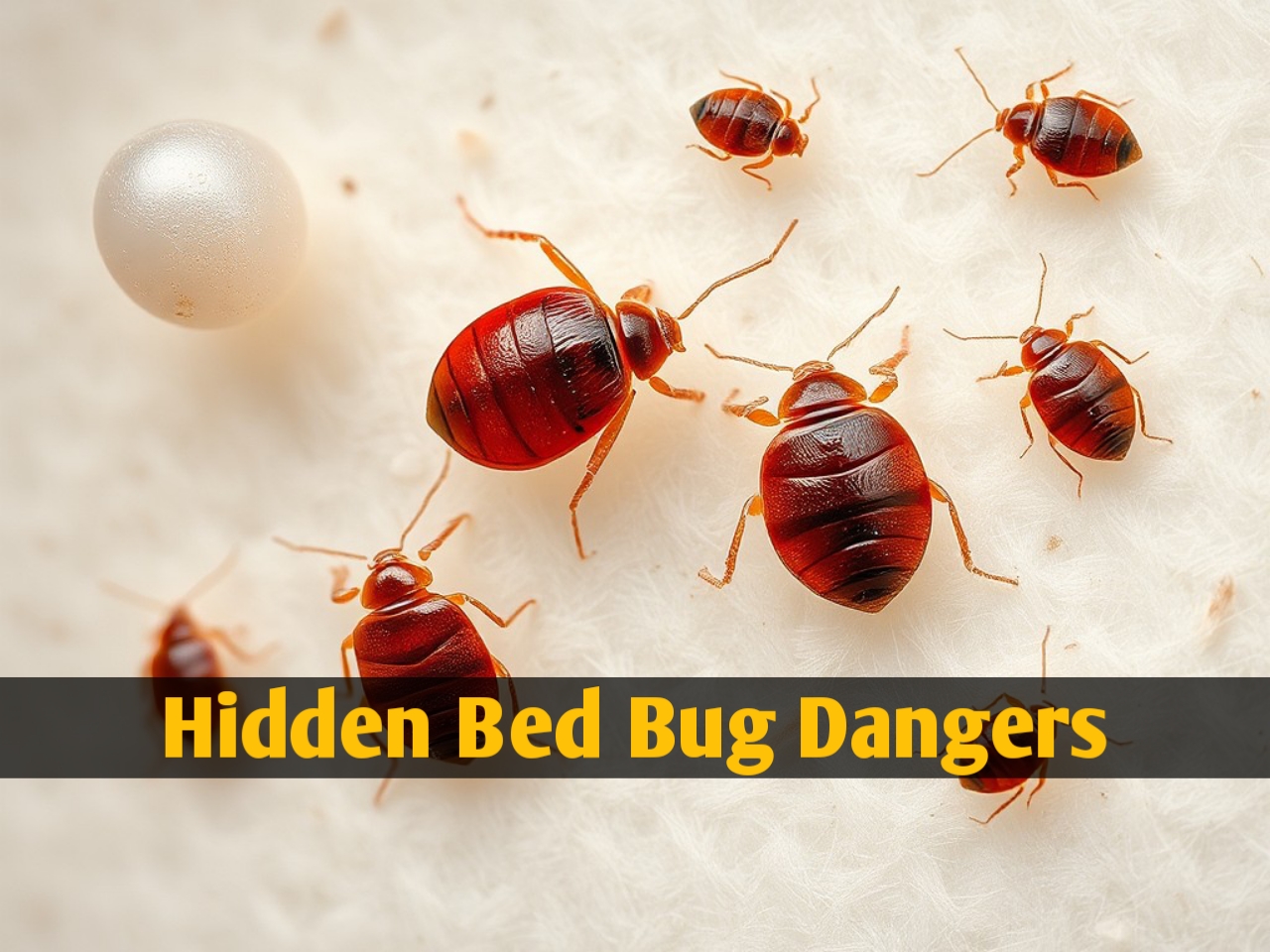How to Identify Bed Bugs: What Do Bed Bugs Look Like Up Close?
Bed bugs have been a rising concern in homes, hotels, and various living spaces around the world. Despite their tiny size, these pests can cause significant distress, leading to sleepless nights, skin irritation, and infestations that are difficult to manage. One of the first steps in controlling and eliminating bed bugs is knowing how to identify them. This guide will help you understand what bed bugs look like up close and offer insights into spotting signs of their presence.
What Exactly Are Bed Bugs?
Bed bugs (Cimex lectularius) are small, parasitic insects that feed exclusively on blood, primarily human blood. These pests have been around for thousands of years, evolving alongside humans. They are often found in places where people sleep, hence the name “bed bugs.” Bed bugs are known for their ability to hide in small crevices and reproduce quickly, making them notoriously difficult to detect and eradicate once they establish an infestation.
Typically, bed bugs are active at night, as this is when they come out to feed. During the day, they hide in cracks and crevices, such as in mattress seams, bed frames, and other furniture close to the host. Their bites often result in red, itchy welts, though not everyone reacts to their bites in the same way. Understanding what they look like is key to identifying an infestation early and taking action to control their spread.
What Do Bed Bugs Look Like at Different Life Stages?
Bed bugs go through five distinct stages before they reach adulthood, and their appearance changes slightly as they grow. Here’s how to identify bed bugs at each stage of their life cycle:
1. Eggs:
Bed bug eggs are tiny, about the size of a pinhead or 1mm in length. They are white or translucent in color and are often found in clusters. The eggs are sticky, which helps them adhere to surfaces such as fabric, wood, or metal. They are typically laid in cracks, seams, or hidden areas close to their host’s sleeping spot. Bed bug eggs are almost impossible to spot without magnification, which is why infestations can easily grow unnoticed in their early stages.
2. Nymphs (Juvenile Bed Bugs):
Nymphs are immature bed bugs, and they pass through five developmental stages (or instars) before becoming adults. After hatching, nymphs are around 1.5mm long and translucent or pale yellow. As they progress through the stages, they molt and become darker in color, turning brownish as they near adulthood. At each stage, nymphs must feed on blood before molting to the next stage, so they often stay hidden until after feeding.
3. Adult Bed Bugs:
Adult bed bugs are about the size of an apple seed, ranging from 4mm to 7mm in length. They are oval-shaped and flat before feeding, but after a blood meal, their bodies swell and become more elongated and reddish-brown. They have six legs and two antennae, and while bed bugs have small wing pads, they cannot fly. Adult bed bugs are often reddish-brown or mahogany-colored and are much easier to spot than their younger counterparts.
Key Features to Look for When Identifying Bed Bugs
1. Shape and Size:
The classic shape of a bed bug is oval and flat, which allows them to hide in small crevices. Adult bed bugs resemble a flat disc when they haven’t fed recently. After feeding, their bodies elongate and take on a swollen, balloon-like appearance. Despite their small size, bed bugs can be seen with the naked eye, especially adults that have just fed.
2. Color:
Bed bugs change color as they mature and after feeding. Newly hatched nymphs are pale yellow and difficult to see, while adults are reddish-brown. After feeding, they appear more reddish due to the blood in their bodies. The color change after feeding is one of the most notable ways to distinguish bed bugs from other small insects.
3. Movement:
Bed bugs do not jump or fly; they move by crawling. They can move relatively quickly for their size, but they prefer to stay hidden in dark crevices during the day. If disturbed, they may move rapidly to find a new hiding place, but they are more often encountered at night when they emerge to feed.
Common Places Where Bed Bugs Hide
One of the challenges in identifying bed bugs is their ability to hide in tiny, inconspicuous places. They can fit into spaces as thin as a credit card, allowing them to conceal themselves in many parts of a home or hotel room. Here are some of the most common places where bed bugs hide:
1. Mattresses and Box Springs:
Bed bugs are notorious for living in mattress seams, tufts, and folds. They are often found in the edges of mattresses and in the creases where the mattress meets the bed frame. Box springs also provide a suitable hiding spot, especially if there are small cracks or crevices they can crawl into.
2. Bed Frames and Headboards:
Wooden bed frames, especially those with cracks or joints, can harbor bed bugs. They may also be found in metal bed frames, particularly where bolts and screws create small gaps. Headboards, which are often overlooked, can be an ideal hiding spot due to the crevices that exist between the wall and the furniture.
3. Furniture and Upholstery:
Bed bugs can hide in couches, chairs, and other upholstered furniture. They may nest in seams, under cushions, or in the wooden framing of furniture. Furniture close to beds or sleeping areas is particularly at risk for infestation.
4. Luggage and Clothing:
When traveling, bed bugs can hitch a ride in luggage, clothing, or personal belongings. Hotel infestations are common, and bed bugs can be introduced to your home through travel-related items. Inspecting luggage, bags, and clothing when returning from a trip is a good practice for preventing an infestation.
5. Wall Cracks and Electrical Outlets:
Bed bugs can hide in cracks in walls, baseboards, and even behind electrical outlets and switch plates. These areas provide dark, hidden places where bed bugs can live undetected. Once inside a wall, they can easily move from room to room, spreading the infestation.
How to Spot Signs of a Bed Bug Infestation
Identifying a bed bug infestation early is crucial for effective treatment and elimination. Here are the most common signs of bed bugs:
1. Blood Stains on Sheets or Pillowcases:
After feeding, bed bugs may leave small blood spots on bed sheets or pillowcases. These stains are typically reddish or rusty in color and can indicate that bed bugs are present in your bedding.
2. Bed Bug Fecal Spots:
Bed bug excrement appears as small, dark spots or smears on bedding, mattresses, or furniture. These spots are usually black or dark brown and may appear in clusters where bed bugs are hiding.
3. Shed Skins and Eggshells:
As bed bugs grow, they molt and leave behind their exoskeletons. These shed skins are pale yellow and can often be found near hiding places like mattress seams or furniture crevices. Additionally, you may find eggshells from newly hatched nymphs.
4. Musty Odor:
In cases of severe infestations, bed bugs may produce a distinct, musty odor. This smell is often compared to the scent of coriander or moldy fabric and is caused by the pheromones that bed bugs release.
Common Misidentifications: Insects That Look Like Bed Bugs
Many other insects can be mistaken for bed bugs, so it’s important to correctly identify them before starting any treatment. Here are a few insects that are commonly confused with bed bugs:
1. Carpet Beetles:
Carpet beetles are small, round insects that can be found in homes, but they do not bite or feed on blood. Unlike bed bugs, they are often found in carpets and upholstery, where they feed on natural fibers.
2. Bat Bugs:
Bat bugs are closely related to bed bugs and look nearly identical. However, bat bugs typically feed on the blood of bats, not humans. If you live in an area with bats, there is a chance you may encounter bat bugs rather than bed bugs.
3. Spider Beetles:
Spider beetles have a round, reddish-brown body that resembles an engorged bed bug. However, they are typically found in pantry areas, where they feed on stored food products.
How to Confirm a Bed Bug Infestation
If you suspect bed bugs but aren’t sure, it’s a good idea to take a closer look using a flashlight and magnifying glass. Search areas where bed bugs are likely to hide, such as mattress seams, bed frames, and behind headboards. If you’re still unsure, it may be best to contact a professional pest control company to conduct a thorough inspection. Pest professionals can use advanced detection tools, such as bed bug dogs or special monitors, to confirm an infestation.
Conclusion: Take Action at the First Sign of Bed Bugs
Bed bugs can cause significant distress and discomfort, but knowing what bed bugs look like up close can help you identify an infestation early. By understanding their appearance, hiding places, and signs of infestation, you can take proactive steps to prevent their spread and eliminate them from your home.
If you discover bed bugs, it’s important to act quickly. Early detection and intervention are the keys to controlling the spread of bed bugs before they become a larger problem. Whether you attempt to treat the problem yourself or seek professional assistance, identifying bed bugs promptly will help you restore your home to a pest-free environment.
Read Also Our This Post: Best Ways on How to Protect Walls from Dog During Storm

Kamran Khatri is a versatile writer and editor at ExpressZone.co.uk, bringing fresh perspectives and insightful commentary across a wide range of topics. With a passion for exploring diverse subjects—from technology, business, and finance to lifestyle, travel, and the arts—Kamran aims to inform, inspire, and engage readers through well-researched articles and thought-provoking content.
His work spans multiple categories including health, education, pets, entertainment, real estate, and sustainability, reflecting his commitment to delivering knowledge that connects with everyday life. Whether breaking down the latest trends, sharing practical tips, or highlighting cultural insights, Kamran’s writing combines clarity with creativity.
When he’s not crafting stories for ExpressZone.co.uk, Kamran enjoys keeping up with global developments, exploring innovative ideas, and connecting with readers who share his curiosity about the world.







